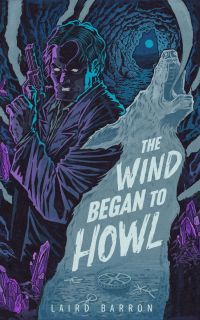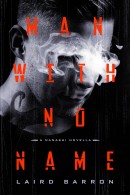21st Century Ghosts
3August 18, 2013 by Laird

A short essay I wrote for LOCUS a few years ago; reprinted for the first time. A handful of authors received the assignment to discuss the state of modern horror. Here’s my take circa 2007.
Twenty-First Century Ghosts
by Laird Barron
Short, dark fiction is close to my heart. I encountered Michael Shea’s The Autopsy as a teenager and it was the first horror story to really scare the hell out of me. I didn’t fully grasp its significance then, couldn’t fully take the measure of his work any more than the blind men could hope to make sense of the elephant. Such appreciation was impossible for a seventeen year old kid, especially a kid who’d been weaned on modern pulps and bad cinema — nonetheless, the power of Shea’s vision was undeniable, and it shook me. This was the latter 1980s when bookstore shelves were hemorrhaging slasher fiction and the latest vampire retreads — the salad days of affect horror. On the day I found a copy of David Hartwell’s The Dark Descent, which featured Shea’s novella and a number of other classics, everything changed. I’d tasted literary horror and once that got into my blood, I was ruined for anything less substantial than the pure stuff. Shea’s dark masterwork remains etched upon my sensibilities as the ultimate example of how a storyteller may capture our wildest, bleakest, most fearful imaginings and bend them to the service of something far greater than an impulse toward the coarse and coarsely visceral. Perhaps more importantly, he demonstrated it was possible to dust off among the hoariest of genre tropes, demonic possession in this case, and transcend it utterly. This feat in itself is a metaphor for the highest quality work accomplished today.
Seven years into the new millennium and the big black carousel has
swung full circle. Horror may never again experience the boom that heralded the Golden Era of the 1970s and early 1980s, but it’s definitely recovering from lean times. The short fiction field is especially resurgent, and its future more assured than it has been in many years. I remark upon this resurgence with such confidence because even the most cursory examination of this decade’s finer work reveals a level of craft that hearkens to models established by the original giants of the canon. The key to the best, most enduring fiction, what truly elevates literary horror above mere affect, lies in a combination of elements, not the least of these an authorial intent to establish a reciprocal relationship with his or her readers, something more profound, something more resonant than a cheap thrill, or transient frisson. This sense of reciprocity was ever prevalent in the works of Shea and his peers, and is equally prevalent among the ranks of authors who represent the leading edge of the genre in 2007.
This leading edge is comprised of an eclectic array of seasoned veterans and relative newcomers. Jeffrey Ford’s Empire of Ice Cream, Terry Dowling’s Basic Black, and William Browning Spencer’s The Ocean and All Its Devices stand as significant recent collections penned by long established authors. Other stalwarts of the short medium, such as Lucius Shepard, Gary Braunbeck, and Joyce Carol Oates show no signs of fading from the scene. Further, a new generation has begun to emerge through independent presses and genre magazines. My faith in the future of short horror fiction is strong because as I read story after story, and collection after collection penned by a host of rising stars, I readily discern character traits of a venerable lineage, and echoes of historic greatness. Caitlin Kiernan’s To Charles Fort, with Love, Joe Hill’s Twentieth Century Ghosts, Margo Lanagan’s surreal and haunting Black Juice, and Conrad Williams’ gritty, phantasmagoric tour de force Use Once, Then Destroy, are of the highest caliber short story collections in recent memory, and arguably the equals of anything that’s appeared over the past thirty years. Literary acumen, attention to character, setting, and plot, are hallmarks shared by the younger standard bearers of the current era. It seems apparent the legacy of writers such as Jackson, Grant, Klein, Straub, and Shea himself have come to fruition in the talents of contemporary authors including, but certainly not limited to, Nathan Ballingrud, Kelly Link, Paul Tremblay, John Langan, Darren Speegle, Mary Rickert, and Elizabeth Bear. These, among a score of others, spring to mind as literary scions of those latter day masters who comprised the original vanguard of the horror genre. Here is a generation cognizant of its roots, one that collectively demonstrates respect for history and tradition, yet is unafraid to re-imagine the architecture of the weird tale and build upon its foundation.
Recalling now that sense of dread wonder and amazement engendered by The Autopsy, I can only envy those who are yet to experience it for the first time. Doubtless twenty years from now a kid will crack open a novella by Matt Cardin or Glen Hirshberg and find himself poleaxed as I was upon discovering Shea. I don’t think the literature of the weird, the canon horrific, could be in better hands.
Share this:
Related
Category: Uncategorized | Tags: essay, john langan, laird barron, locus, michael shea, ramsey campbell







[…] Autopsy, by Michael Shea. (In The Autopsy and Other Tales.) In Laird’s words: “The first horror story to really scare the hell out of […]
Simply want to say your article is as astonishing.
The clearness on your post is simply great and i can suppose you are
a professional on this subject. Well along with your permission allow me to clutch
your feed to stay up to date with forthcoming post.
Thank you one million and please keep up the rewarding work.
[…] Source: 21st Century Ghosts […]